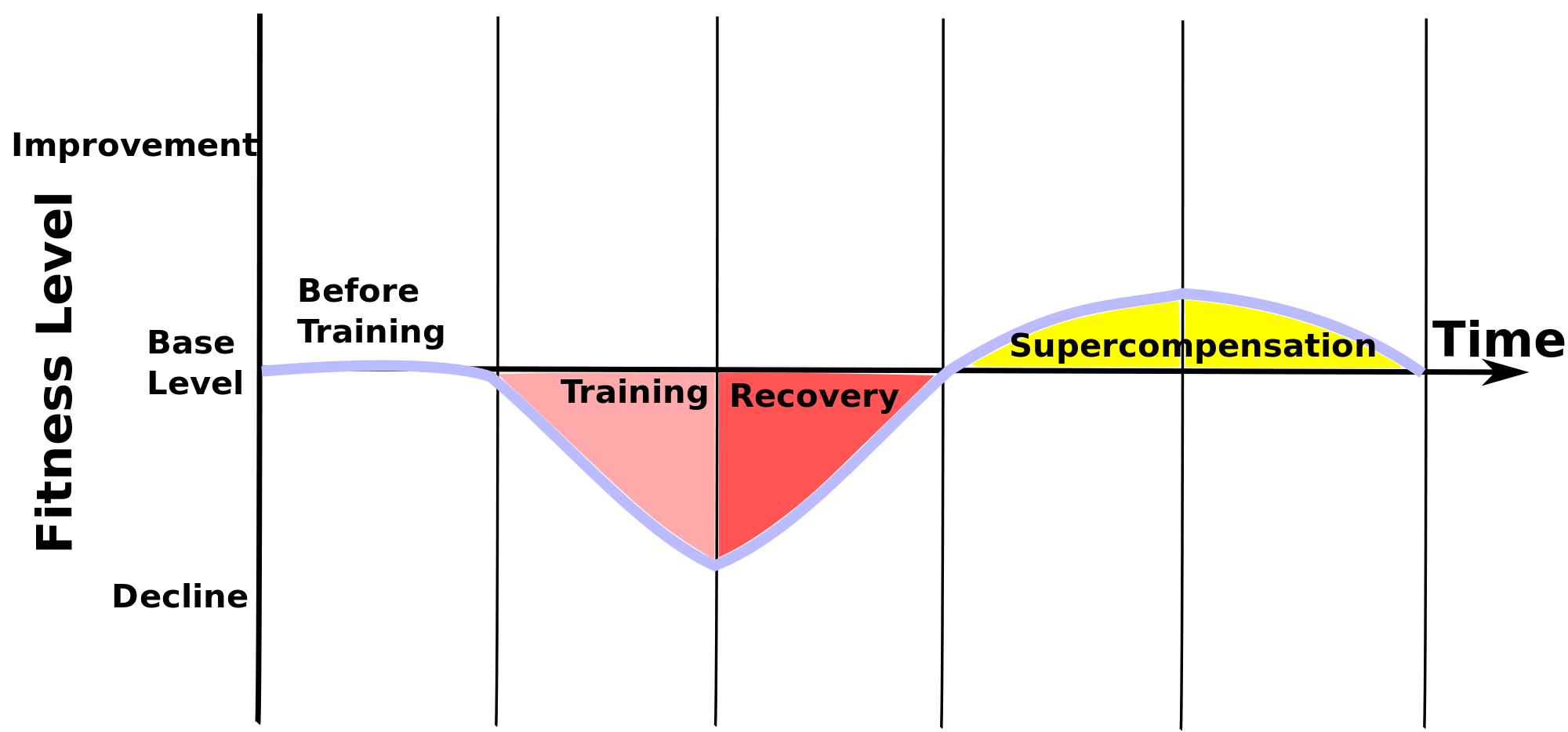Deloading is a Waste of Your Time


By Jordan Syatt
Most of my clients don’t deload.
And, by and large, I think the traditional week-long deload is a monumental waste of time.
Worth noting, I’m an Elite ranked powerlifter holding 3 IPA Raw Junior World Records and am only a hair’s breadth away from deadlifting 4x, squatting 3x, and benching 2x my bodyweight.
I’m not some random schmuck off the street blowing hot air for shits and gigs.
I’ve been in the iron game for a long time and, through inordinate amounts of trial and error, I’ve realized the traditional deload that we’ve been told is essentialis actually…well…not.
To understand why, let’s start from the very beginning.
What Is a Deload?
A deload is a purposeful reduction in training volume & intensity for the purposes of recovery, injury prevention, and improved performance.
The concept of deloading stems from the law of supercompensation.

Supercompensation represents the training process in 3 major phases.
Phase 1: Application of Stress
The applied stress is comprised of the workout in question and everything therein. For example, when talking about the applied stress, you can be referring to an individual repetition, an entire set, or even the workout as a whole. The stress (workout) causes fatigue, muscular damage, etc which necessitates the second phase.
Phase 2: Recovery
Be it active rest between sets, an entire day of rest between workouts, or a whole week geared towards recovery, phase 2 allows the body to recover and regenerate back to baseline.
Phase 3: Supercompensation
The 3rd phase, sometimes referred to as therebound phase, is when the body effectively rebounds from a fatigued state to a new, higher level of performance.
How Does This Relate to a Deload?
The deload is phase 2: the recovery phase.
Created with the intentions of aiding recovery, avoiding overuse injuries, and realizing a higher level of performance, the traditional deload week is often touted as an essential component of everyone’s training program.
I disagree.
But more on that later.
What Does the Traditional Deload Week Look Like?
A typical deload week is loosely based around the following three guidelines:
1. One full and pre-planned week of little-to-no training stress following three weeks of relatively high training volumes and intensities.
2. Do not exceed 40-60% of your one repetition maximum (1RM) the entire week.
3. Emphasize mobility drills, soft tissue work, and non-strenuous bodyweight exercises.
While not inherently bad recommendations – they all certainly have a time and place - these, like all generalized guidelines, fail to take the individual trainee and their specific needs, goals, and preferences into account.
As a result, we’re left with absolutist recommendations that, while beneficial for some, leave others with sub-optimal guidelines.
Is the Traditional Deload Good For Anyone?
Of course.
While it’s not right for everyone, there are certain populations who benefit from this style of programming.
To name a few:
1. Professional Athletes: Not to be confused with high level weight lifters, professional athletes greatly benefit from utilizing the traditional deload. Reason being, the main priority when coaching pro athletes is to minimize the risk of injury while maintaining/improving performance. In this case, deloading every fourth week is a simple and effective strategy to reduce stress on the body while still getting a sufficient training effect.
2. Old(er) and Experienced Lifters: The older we get the harder it becomes to adequately recover from strength training. As such, when working with older (think 30yrs+) and experienced lifters it’s smart to incorporate the traditional deload as a means of preventing overuse injuries while simultaneously improving performance. I’d note, an older individual with little-to-no strength training experience likely doesn’t need to deload as the weights they’re handling won’t be anywhere near challenging enough.
3. Trainees with Recurring Injuries: If a lifter is continually getting hurt over and over again…they should first check their exercise technique and general programming strategies as that’s where they’re probably screwing up. That being said, with individuals who appear to be more injury-prone, incorporating a traditional deload is a smart strategy to use in order to reduce their risk of pain and injury.
So…What’s Wrong with the Traditional Deload?
A lot.
Not only does it neglect individual needs and preferences, it fails to account for inevitable variances in how you feel on a day-to-day basis.
Cybernetic periodization, a term coined by the late Mel Siff, essentially refers to accounting for and modifying your program based on your subjective perceptionof how the weights feel on that specific day.
This skill, learning how to listen to your body and understand what it needs based on how you feel, is arguably the single most important skill to master for both coaches and lifters a like.
Unfortunately, the traditional deload completely neglects cybernetic periodization.
To illustrate…
Imagine you walk into the gym feeling incredible.
You power through your warm-up and can’t wait to get under a heavy bar.
Today’s going to be a PR setting kind of day.
You can feel it.
You reach into your gym bag, unfold your training program, scan to the current week and immediately feel your stomach plummet.
It’s deload week.
Your coach told you to absolutely never deviate from the program.
No matter what.
So, now, even though you feel incredible you need to scale your training back to a point that feels unproductively easy.
And this is all based on the assumption that this rest week is going to make you better in the long-run?
I call bull shit.
The idea that you need to deload every 4 weeks in order to adequately recover is false.
Period.
Does it work?
Yea, of course. Big whoop. Everything works.
Is it essential?
Absolutely not.
I know countless high level lifters of world class caliber who have never utilized the traditional deload week.
Not even once.
Personally, I can count on 1-hand how many week-long deloads I’ve taken in my entire life and they were because I was sick, travelling, and/or swamped with work.
My Point is This…
We’ve been led to believe the traditional deload is absolutely essential to your long-term health and success in strength training
But that’s a myth.
You don’t need to deload every 4 weeks to get the most out of your training.
You just don’t.
And while it goes against what we’ve been told for years and years, it’s the truth.
Am I saying the traditional deload is worthless?
Of course not.
It obviously works and it works very well.
But what I am saying is that it’s not essential and if you don’t want to do it then you don’t have to.
What’s more…
There’s More Than 1 Way to Deload
Shocker, huh?
Whoulda thunk there was more than 1 way to take a rest from training and allow your body sufficient time to recover?
The reality is there are countless ways to deload effectively that doesn’t include pre-planning an entire easy week of training.
More importantly, there are ways to incorporate both cybernetic periodization and sufficient deloading periods that will allow you to truly get the most bang for your buck.
Here are 3 of my personal favorites:
The Autoregulatory Deload
Reserved for only my most advanced lifters, I also call this the play it by ear deload.
Essentially, this deloading strategy entails taking a light or easy day only when your body really needs it.
There are no planned deloads.
None.
Per usual, as in any good program, there will be waves of varying volumes and intensities but none of your deloads will be pre-planned.
Instead, you’ll focus on listening to your body and understanding when it’s time to push the envelope as well as when it’s smarter to back off.
Through following this strategy you will have much more variability in your training but, in my experience, this is unquestionably the best method for highly advanced lifters.
How’s it work?
Simple.
- Feel
amazing? Follow the program as-is and push yourself to the
limit. You better be trying to hit some big PR’s.
- Feel
good? Follow the program as-is and lift some serious
weight. No need to go balls-to-the-wall but definitely push yourself.
- Feel
eh?
Follow the program as-is but don’t feel obligated to do anything crazy. Use
this as more of a technique day and focus on getting all of your reps with
perfect form without stressing too much about the load.
- Feel
like dog shit? You have two options:
- Follow the program as-is but drastically reduce the days overall volume & intensity. You should be in & out of the gym in less than 30-min.
- Take the day away from the barbell and go through some movement therapy. Warm-up, foam roll, and do some light bodyweight exercises just to get the blood pumping. You should be in & out of the gym in less than 30-min.
What’s important to note about the autoregulatory deload is that you don’t need to spend an entire week taking it easy in the gym.
Rather, you go in every day and moderate intensity based on how you feel.
It takes a lot of dedicated practice and honest self assessment to become proficient with it, but once you learn how to do it properly you’ll never go back to the traditional deload.
The Max Effort Deload
Similar to the play it by ear deload, this strategy prioritizes cybernetic periodization but with slightly more structure.
Here’s how it works:
1. Plan to have 2 back-to-back deload days (not weeks) every 4-8 weeks. Personally, I’ve found the 6-week mark to be the sweet spot for most lifters.
2. You don’t need to plan the exact deload days, but just know going into the program that between weeks 4 & 8 you are going to take 2 light(er) days when you feel like you need them most.
3. When those 2 days come around (usually at the 6-week mark), reduce the load or completely nix your max effort (main strength) movements. In other words, drop the weight to somewhere between 40-65%1RM or just skip them entirely and move on to your pre-planned accessory work.
Depending on how you feel, you can either go after your accessory work really hard or take it nice and easy to give your body a bit of a break.
It all depends on how you feel.
The Reverse De-Load
The most structured of my deloading strategies, this is my version of the traditional week-long deload and, in my opinion, it makes a lot more sense.
While it doesn’t inherently account for cybernetic periodization – that’d be something the individual would have to pay attention to on a daily basis either way – the structure allows for a great deal of variance and progression based on how you feel.
Here’s how it works:
- Week
1:
The first week is your “deload” week. Seeing as it’s the first week of the
program, this is the time for you to feel things out, get confident with the
program, and focus on perfecting technique in all movements. As an added benefit,
through taking an initial light(er) week it should drastically help to reduce
delayed onset muscle sorness (DOMS) at the initiation of the program.
- Weeks
2 – 4: Each subsequent week should become progressively
more challenging from a volume and/or intensity perspective.
This is where cybernetic periodization comes into play – you really need to base every training day on how you feel – but, generally speaking, weeks 2-4 are meant to become progressively more difficult.
Then, once Week 5 rolls around, you’re ready for another “deload” week which will be spent getting to understand your new program, mastering technique, and prepping for the following 3 weeks.
Making Sense of It All
The fitness industry is rife with myths, fallacies, & dogma and, I’ll be honest, it pisses me off to no end.
While glamorizing the traditional deload is far from the worst thing I’ve ever heard, touting it as the end-all-be-all of strength training is a display of pure ignorance.
Like everything in the fitness industry, the deload is neither the best nor worst thing in the world. Per usual, the effectiveness of the deload is almost entirely based on the individual, their needs, goals, preferences, and how intelligently they utilize it within their programming.
So what should you do?
Experiment with them all and find what works best for you.
There is no “right” or “wrong” with this stuff.
When I said everything works I truly meant it.
Everything does work.
Strength is far less complicated than most internet experts make it out to be.
Lift weight.
Eat and sleep
Lift more weight.
Repeat.
Never Minimal. Never Maximal. Always Optimal.
ABOUT THE AUTHOR

Jordan Syatt is a strength training and nutritional consultant. He is a World Record Powerlifter, featured in publications such as T-Nation, Muscle & Fitness, and Men’s Fitness Magazine. He is also Precision Nutrition Certified, Westside-Barbell Certified and owner of http://www.syattfitness.com.
Website: http://www.syattfitness.com/
Facebook: https://www.facebook.com/syattfitness
Twitter: https://twitter.com/SyattFitness
